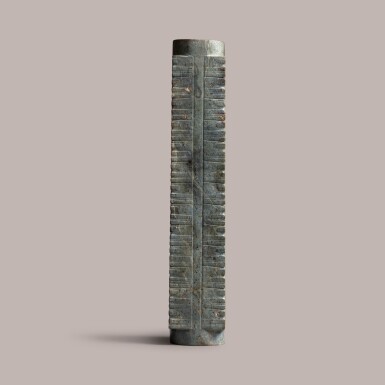
a large mottled green jade cong, Neolithic period, Liangzhu culture | 新石器時期/良渚文化 玉琮
Auction Closed
November 4, 11:45 AM GMT
Estimate
300,000 - 500,000 GBP
Lot Details
Description
a large mottled green jade cong
Neolithic period, Liangzhu culture
新石器時期/良渚文化 玉琮
of cylindrical form with square projections on four corners, the sides slightly tapering towards the base, each corner carved with stylised mask comprising twin bands of narrow parallel grooves above incised circular ‘eyes’ and a short raised band with rounded ends for the ‘nose’, the dark green jade mottled and streaked with cloudy off-white and black inclusions
Height 37.8 cm, 14¾ in.
Acquired in Hong Kong, 1999.
1999年購自香港
From the Land of Asia, Pointe-à-Callière Museum, Montréal, 17th November 2016 - 19th March 2017.
From the Land of Asia, Kimbell Art Museum, Texas, 4th March – 19th August 2018.
《From the Land of Asia》,Pointe-à-Callière 博物館,蒙特利爾,2016年11月17 - 2017年3月19日
《From the Land of Asia》,Kimbell美術館,德克薩斯,2018年3月4 - 8月19日
Fillippo Salviati, Radiant Stones: Archaic Chinese Jades, 2004, Honkong, no.12.
Jean-Paul Desroches, Two Americans in Paris, A Quest for Asian art, 2016, Paris, no.39.
Fillippo Salviati 編《Radiant Stones: Archaic Chinese Jades》, 2004年,香港,圖版12
Jean-Paul Desroches編 《Two Americans in Paris, A Quest for Asian art》,2016年,巴黎, 圖版39
Cong can vary enormously in height and diameter, ranging from wide, shallow bracelets to tall, narrow tubes such as the present lot. One of the tallest surviving cong, formerly in the collection of George Eumorfopoulos (1863-1939), is now preserved in the British Museum, London (accession no. 1937,0416.188). Multi-tiered cong comparable to the present piece are preserved in major museums around the world. See two cong of 13 sections but shorter than the present piece; one in dark green, excavated from Wujin, Jiangsu province in 1982, now preserved in the Nanjing Museum, illustrated in Liangzhu wenhua yuqi / Jades from the Liangzhu Culture, Hong Kong, 1989, pl. 45; the other in lighter colour, preserved in the Freer Gallery of Art, Washington D.C. (accession no. F2016.2). Compare also two cong closer in size to the present lot but of 15 sections; a slightly taller one, preserved in the Shanghai Museum, included in the exhibition Gems of Liangzhu Culture: From the Shanghai Museum, Hong Kong Museum of History, Hong Kong, 1992, cat. no. 56; and a slightly shorter piece, preserved in the Palace Museum, Beijing, included in the Museum’s exhibition Liangzhu yu gudai Zhongguo: Yuqi xianshi de wuqian nian wenming / Liangzhu and Ancient China: The 5,000-Year Civilization Demonstrated by Jades, Beijing, 2019, cat. no. 203.
Although the modern discovery of the Liangzhu culture began in the 1930s, its jade artefacts appear to have been unearthed in earlier times. From around the Southern Song dynasty (1127-1279), ceramic vases in the form of cong were produced, as evidenced by a tall Longquan celadon cong-style vase from the Qing Court collection and still preserved in the Palace Museum, Beijing (accession no. gu-145247), illustrated in Longquan of the World. Longquan Celadon and Globalization, vol. 2: State Vessels, Beijing, 2019, pl. 16. Ming Wilson (Chinese Jades, London, 2004, pp. 15-16) suggests that the Song potters might have been inspired by the jade cong unearthed during the construction of their new capital at Lin’an, modern-day Hangzhou, where many cong were found in recent decades.
You May Also Like





